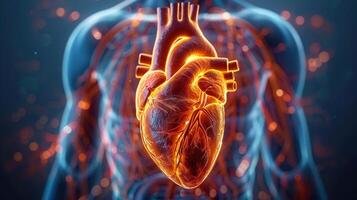Discover how your heart’s natural electrical system works, why it’s essential for life, and how to recognize when your rhythm might be out of tune.

Introduction: The Music of Life Inside Your Chest
If your heart were an orchestra, it would have a single, tireless conductor working 24/7, making sure every musician — or in this case, every heartbeat — plays in perfect time. This conductor isn’t a person, of course. It’s your heart’s electrical system, an intricate network of specialized cells that sends tiny signals telling your heart when to squeeze, when to relax, and how fast or slow to go.
You rarely think about it — and that’s the point. Your heartbeat is automatic. You don’t need to “remember” to keep it going any more than you have to remind your lungs to breathe. But when the heart’s electrical rhythm falls out of sync, the results can range from mild symptoms to serious medical emergencies.
Understanding how your heart’s conductor works can help you appreciate the incredible precision of this vital organ and recognize when something might be amiss.
Understanding the Heart’s Electrical System
Your heart is more than a muscular pump — it’s also a finely tuned bioelectric machine. Every beat starts with a small electrical impulse, traveling in a carefully choreographed path that ensures each chamber contracts at the right time.
The heart’s electrical “roadmap” includes:
- Sinoatrial (SA) Node: Often called the natural pacemaker, located in the right atrium. It sets the pace for the entire heart by generating the initial electrical signal.
- Atrioventricular (AV) Node: Acts as a relay station, delaying the signal just long enough for the atria to squeeze blood into the ventricles before they contract.
- Bundle of His & Purkinje Fibers: Specialized pathways that quickly deliver the electrical impulse to the ventricles, making sure they contract forcefully and together.
Think of it like a stadium wave: one section starts, the next joins in perfect timing, and the energy flows around until the whole crowd is in motion.
How the Electrical Signals Are Generated
You might be surprised to learn your heart doesn’t need a plug, batteries, or any outside electrical source. The SA node creates its own current through a process called depolarization. This involves the movement of charged particles — mainly sodium, potassium, and calcium — across the membranes of heart cells.
These tiny voltage changes spark the signal that travels through the heart’s wiring system. The process repeats over and over, from birth to your last breath, typically 60 to 100 times per minute at rest.
This built-in self-starter is why donor hearts in transplant surgeries can start beating as soon as blood supply is restored — even outside the body, the heart has its own electrical life force.
Why Rhythm Matters
The precise timing of electrical signals keeps your heartbeat regular and efficient. If the rhythm is too slow (bradycardia), your organs might not get enough oxygen-rich blood. Too fast (tachycardia), and the heart may not have time to fill between beats. Irregular rhythms (arrhythmias) can cause symptoms like palpitations, dizziness, shortness of breath, or even loss of consciousness.
One common example is atrial fibrillation (AFib), where chaotic signals in the atria cause them to quiver instead of contract properly. While not always immediately dangerous, AFib increases the risk of stroke and heart failure. On the other end of the spectrum, dangerous ventricular arrhythmias can stop the heart entirely if not treated within minutes.
Your heart’s electrical system isn’t just about keeping time — it’s about keeping you alive.
How We Detect Heart’s Electrical Activity
Doctors use several tools to “see” the heart’s electrical activity:
Electrocardiogram (ECG or EKG)
The most common test, using electrodes on the skin to record electrical signals as wave patterns. These patterns reveal rhythm, rate, and possible areas of damage or strain.
Holter Monitors & Event Recorders
Portable devices worn for 24 hours or longer to catch rhythm problems that may not show up during a short office ECG.
Wearable Technology
Smartwatches and fitness trackers with ECG features can help detect irregular rhythms between doctor visits. While not a substitute for medical-grade equipment, they’ve alerted many people to issues that might otherwise have gone unnoticed.
Everyday Clues Your Electrical System Might Be Off
Sometimes, your body gives hints that your heart’s conductor is missing a beat — literally or figuratively. You might notice:
- Unexpected Palpitations: Feeling like your heart is racing, pounding, or skipping beats.
- Dizziness or Lightheadedness: Caused by momentary drops in blood flow to the brain.
- Unexplained Fatigue: A slow or irregular heartbeat can make daily activities more tiring.
- Shortness of Breath or Chest Discomfort: Especially during exertion.
These symptoms don’t always mean something is wrong, but they’re signals worth checking with a medical professional.
Real-Life Relevance: Why You Should Care Now, Not Later
Many rhythm problems develop gradually. At first, you might only notice an occasional flutter or momentary dizziness. It’s easy to brush these off, especially if they happen when you’re stressed or tired. But small electrical disturbances can be early signs of bigger issues down the road.
Think of your car’s engine light — ignoring it might be fine for a short trip, but you risk a breakdown if you keep driving without investigating the cause. Likewise, listening to your body and seeking evaluation when something feels off is an investment in your long-term heart health.
When to Seek a Cardiac Evaluation
If you ever faint without warning, experience chest pain with palpitations, or have shortness of breath that comes on suddenly, get medical attention immediately.
Even if your symptoms are milder — like occasional skipped beats or fatigue that’s out of proportion to your activity — it’s worth a conversation with a healthcare provider. Early evaluation can lead to simple fixes, lifestyle adjustments, or preventive care that helps avoid emergencies later.
The Future of Heart Rhythm Monitoring
We’re entering an era where heart rhythm monitoring could be as routine as checking your steps. Advances in remote monitoring, AI-driven ECG interpretation, and implantable loop recorders mean more people can be diagnosed earlier and monitored from home.
Some devices now send data directly to your doctor, flagging patterns that might need attention long before you notice symptoms. As technology continues to evolve, catching electrical issues early will become easier — and treatment more personalized.
Conclusion: Keeping the Beat
Your heart’s electrical system is a marvel of biology — a built-in conductor orchestrating every beat of your life’s soundtrack. When it’s working well, you probably don’t give it a second thought. But understanding how it works, and how to recognize when it might be out of sync, empowers you to protect your health.
You don’t need to become an expert in electrophysiology to care for your heart, but you do need to listen to it — both figuratively and literally. If something feels different, don’t dismiss it. A quick check-up could keep your rhythm steady for years to come.
References
- U.S. National Library of Medicine – How the Heart Works
- American College of Cardiology – Understanding Arrhythmias
- National Heart, Lung, and Blood Institute – Heart’s Electrical System
Mayo Clinic – Electrocardiogram (ECG or EKG)
Disclaimer
This article is for educational purposes only and is not a substitute for professional medical advice. Always seek the guidance of a qualified healthcare provider with any questions you may have about your health or a medical condition.









